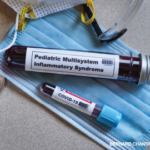Diffuse Pulmonary Intravascular Coagulopathy
Dr. McGonagle next discussed work that he and his collaborators have published evaluating the lung-restricted vascular immunopathology in COVID-19 pneumonia. MAS, or secondary hemophagocytic lymphohistiocytosis, involves an acute consumptive coagulopathy that leads to disseminated intravascular coagulation (DIC). In severe COVID-19, lung pathology demonstrates significant microvascular thrombosis and hemorrhage linked to extensive alveolar and interstitial inflammation that has a MAS-like appearance.
Dr. McGonagle and colleagues thus coined the phrase diffuse pulmonary intravascular coagulopathy to refer to this process, which in its early stages is distinct from DIC. Because coronaviruses often show tropism for angiotensin-converting enzyme 2 on type II pneumocytes, which are adjacent to much of the pulmonary vascular network, this may explain the appearance of diffuse pulmonary intravascular coagulopathy in patients with severe COVID-19 disease, particularly in the context of the intense multifaceted inflammatory reaction seen in such patients.3
Dennis McGonagle, FRCPI, PhD, discussed the distinctive form of pulmonary immunovascular thrombosis that is seen with COVID-19 disease & how the pathophysiology of disease has come to be understood over time.
Role of Anticoagulation
In discussing the implications of pulmonary intravascular coagulopathy, Dr. McGonagle explained that the role of anticoagulation continues to be of extreme interest. Two large trials have been published this past year in The New England Journal of Medicine evaluating the effects of therapeutic anticoagulation with heparin in patients with COVID-19. In one study, researchers used an open-label, adaptive, multiplatform, controlled trial design to randomly assign hospitalized, non-critically ill patients with COVID-19 (i.e., patients without need for critical care-level organ support at enrollment) to receive either therapeutic-dose anticoagulation with heparin or usual-care pharmacologic thromboprophylaxis.
The primary outcome was organ support-free days, evaluated using a scale that combined in-hospital death and number of days free of cardiovascular or respiratory organ support up to day 21 in patients who were ultimately discharged from the hospital. Among 2,219 patients, therapeutic-dose heparin or low molecular weight heparin (LMWH) appeared to increase the probability of survival to hospital discharge with a reduced need for organ support (with an adjusted absolute between-group difference of 4%; 95% confidence interval of 0.5% to 7.2%), though with more major bleeding with heparin or LMWH treatment than with thromboprophylaxis (1.9% vs. 0.9%).4
In contrast, a trial using the same design that was conducted among 1,098 patients who were critically ill with COVID-19 concluded that therapeutic-dose heparin or LMWH did not improve the primary outcome of days without organ support as compared to usual care pharmacologic thromboprophylaxis. Moreover, use of therapeutic-dose heparin or LMWH was associated with more major bleeding complications than usual-care prophylaxis (3.8% vs. 2.3%).5


